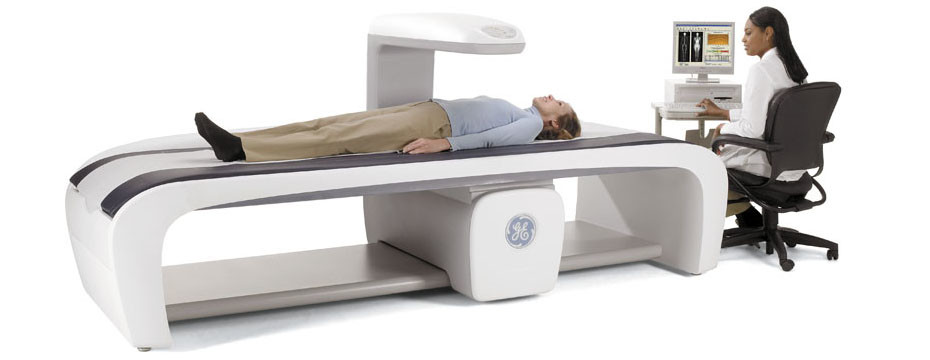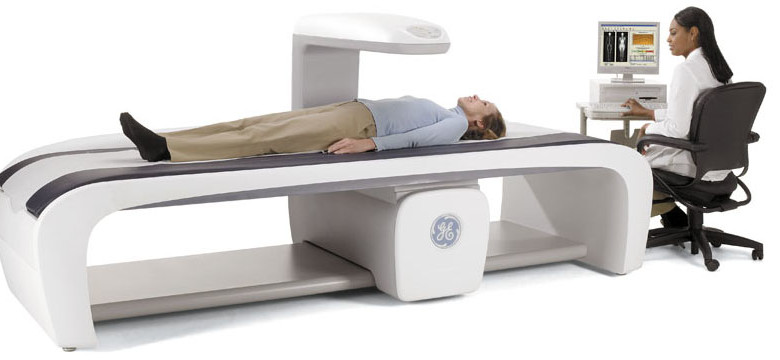Bone Densitometry

What is a Bone Density Scan (DEXA)?
Bone density scanning, also called dual-energy x-ray (DEXA) or bone densitometry, is an enhanced form of x-ray technology that is used to measure bone loss. DEXA is today’s established standard for measuring bone mineral density (BMD).
An x-ray (radiograph) is a noninvasive medical test that helps physicians diagnose and treat medical conditions. Imaging with x-rays involves exposing a part of the body to a small dose of ionizing radiation to produce images of the inside of the body. X-rays are the most frequently used form of medical imaging.
DEXA is most often performed on the lower spine and hips. In children and some adults, the whole body is sometimes scanned. Other devices that use x-ray or ultrasound are sometimes used to screen for low bone mass.
What are some common uses of the procedure?
DEXA is most often used to diagnose osteoporosis, a condition that often affects women after menopause but may also be found in men and rarely in children. Osteoporosis involves a gradual loss of calcium, as well as structural changes, causing the bones to become thinner, more fragile and more likely to break.
DEXA is also effective in monitoring the effects of treatment for osteoporosis and other conditions that may cause bone loss.
The DEXA test is also used to asses an individual’s risk for developing fractures. The risk of fracture is affected by age, body weight, history of prior fracture, family history of osteoporotic fractures and life styles that include cigarette smoking and excessive alcohol consumption.
Bone density testing is strongly recommended if you:
- have a personal or maternal history of hip fracture or smoking.
- have had a fracture after only mild trauma.
- urinalysis which have shown excessive levels of collagen.
- are a man with clinical conditions associated with bone loss.
- are a post-menopausal woman and not taking estrogen or hormonal supplements.
- are a post-menopausal woman who is tall (over 5 feet 7 inches) or thin (less than 125 pounds).
- use medications that are known to cause bone loss, including corticosteroids such as Prednisone, various anti-seizure medications such as Dilantin and certain barbiturates, or high-dose thyroid replacement drugs.
- has diabetes, liver disease, kidney disease or a family history of osteoporosis.
- have a thyroid conditions such as hyperthyroidism, or a parathyroid condition, such as hyperparathyroidism.
- have had x-ray evidence of vertebral fracture or other signs of osteoporosis.
The Lateral Vertebral Assessment (LVA), a low-dose x-ray examination of the spine to screen for vertebral fractures that is performed on the DXA machine, may be recommended for older patients, especially if:
- have unexplained back pain.
- they have lost more than an inch of height.
- if a DEXA scan gives borderline readings.
How should I prepare?
On the day of the exam you may eat normally. You should not take calcium supplements for at least 24 hours before your exam.
You should wear loose, comfortable clothing, avoiding clothing that has zippers, belts or buttons made of metal. Personal items such as keys or wallets that would be in the area being scanned should be removed. You may be asked to remove some or all of your clothes and to wear a gown during the exam. You may also be asked to remove jewelry, removable dental appliances, eye glasses and any metal objects or clothing that might interfere with the x-ray images.
Inform your physician if you recently had a barium examination or have been injected with a contrast material for a computed tomography (CT) scan or radioisotope scan. You may have to wait 10 to 14 days before undergoing a DEXA test. Women should always inform their physician and x-ray technologist if there is any possibility that they are pregnant.
How does the procedure work?
The DEXA machine sends a thin, invisible beam of low-dose x-rays with two distinct energy peaks through the bones being examined. One peak is absorbed mainly by soft tissue and the other by bone. The soft tissue amount can be subtracted from the total and what remains is a patient’s bone mineral density.
DEXA machines have special software that compute and display the bone density measurements on a computer monitor.
How is the procedure performed?
This examination is done on an outpatient basis.
During the DEXA examination, which measures bone density in the hip and spine, the patient lies on a padded table. An x-ray generator is located below the patient and an imaging device, or detector, is positioned above.
To assess the spine, the patient’s legs are supported on a padded box to flatten the pelvis and lower (lumbar) spine. To assess the hip, the patient’s foot is placed in a brace that rotates the hip inward. In both cases, the detector is slowly passed over the area, generating images on a computer monitor.
The technologist will instruct you to hold very still for a few seconds while the x-ray picture is taken to reduce the possibility of a blurred image.
The peripheral tests are simpler. The finger, hand, forearm or foot is placed in a small device that obtains a bone density reading within a few minutes.
The DEXA bone density test is usually completed within 10 to 30 minutes, depending on the equipment used and the parts of the body being examined.
You will probably be asked to fill out a questionnaire that will help the doctor determine if you have medical conditions or take certain medications that either increase or decrease your risk of a fracture. The medical conditions or take certain medications that either increase or decrease your risk of a fracture.
What will I experience during and after the procedure?
Bone density tests are a quick and painless procedure.
Routine evaluations every two years may be needed to monitor significant change in bone mineral density, decrease or increase. Few patients, such as patients on high dose steroid medication, may need follow-up at six months.
Who interprets the results and how will I get them?
A radiologist, a physician specifically trained to supervise and interpret radiology examinations, will analyze the images and send a signed report to your primary care or referring physician, who will discuss the results with you.
Your test results will be in the form of two scores:
T score — This number shows the amount of bone you have compared with a young adult of the same gender with peak bone mass. A score above -1 is considered normal. A score between -1 and -2.5 is classified as osteopenia (low bone mass). A score below -2.5 is defined as osteoporosis. The T score is used to estimate your risk of developing a fracture.
Z score — This number reflects the amount of bone you have compared with other people in your age group and of the same size and gender. If this score is unusually high or low, it may indicate a need for further medical tests. Small changes may normally be observed between scans due to differences in positioning and usually are not significant.
What are the benefits vs. risks?
Benefits
- No anesthesia is required.
- DEXA bone densitometry is a simple, quick and noninvasive procedure.
- The amount of radiation used is extremely small—less than one-tenth the dose of a standard chest x-ray, and less than a day’s exposure to natural radiation.
- DEXA bone density testing is the most accurate method available for the diagnosis of osteoporosis and is also considered an accurate estimator of fracture risk.
- No radiation remains in a patient’s body after an x-ray examination.
- X-rays usually have no side effects in the typical diagnostic range for this exam.
Risks
There is always a slight chance of cancer from excessive exposure to radiation, however, the benefit of an accurate diagnosis far outweighs the risk.
- The effective radiation dose for this procedure varies. No complications are expected with the DEXA procedure.
- Women should always inform their physician or x-ray technologist if there is any possibility that they are pregnant.
Please visit www.Radiologyinfo.org for more information on this procedure.

